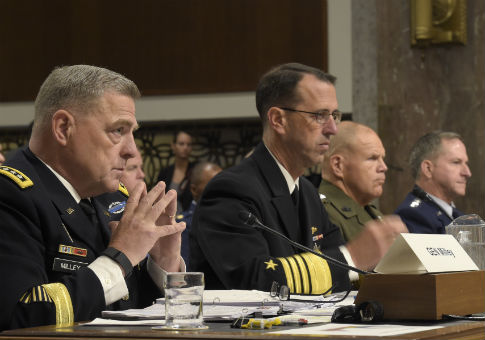The leaders of the four U.S. military services said Thursday that their forces will not be able to defend America if sequestration continues.
In testimony before the Senate Armed Services Committee, leaders of the Army, Navy, Marine Corps, and Air Force agreed that budgetary constraints and uncertainty have forced the services to invest in current readiness at the expense of other priorities.
Sen. John McCain (R., Ariz.), a Navy veteran and the chair of the Armed Services Committee, asked each of the service leaders if they believe they "would have the resources and ability to defend this nation against present and future threats if we continue down this path of sequestration."
They all replied no.
Thursday morning’s hearing was convened to spotlight long-term budgetary challenges facing the U.S. military and featured testimony from Gen. Mark Milley, chief of staff of the Army; Adm. John Richardson, chief of naval operations; Gen. Robert Neller, Commandant of the Marine Corps; and Gen. David Goldfein, chief of staff of the Air Force.
In opening remarks, each of the service leaders explained that sequestration and budgetary uncertainty have forced them to make trade-offs, prioritizing readiness to meet current commitments at the expense of modernization. They emphasized that budgetary constraints threaten the U.S. military’s ability to provide adequate forces in the event of a conflict with global competitors such as China and Russia.
Defense spending has been squeezed each year as a result of the 2011 Budget Control Act, which has been projected to cut $500 billion from defense spending in the decade after its passage. The Defense Department has also weathered billions of dollars in cuts as a result of sequestration, which went into effect in 2013.
McCain noted during opening testimony that the current defense budget is more than $150 billion less than it was in fiscal 2011.
"Rising threats and declining budgets have lead to shrinking military forces that are struggling to sustain higher operational tempo with aging equipment and depleted readiness, and doing so at the expense of modernizing to deal with the threats of tomorrow," McCain said. "Our services are cannibalizing themselves to keep up with recent deployments."
Military officials and government reports have consistently shed light on the negative effects of budgetary constraints on the force. According to a Government Accountability Office report issued earlier this month, the military has reported persistently low readiness levels amid continued demands on forces. The Pentagon also lacks a comprehensive plan to rebuild readiness across the services, according to the report.
Milley said that the Army will be challenged to sustain current counter-terror operations for several years while simultaneously rebuilding its "capability in ground combat against higher-end, near-peer, great power threats" given budget constraints. He said that any future contingency operation with an emerging competitor would "likely require significant commitment of U.S. Army forces on the ground," which the service would struggle to provide.
"Currently, the Army provides 52 percent of all the global combatant commander demand for military forces, and we provide 69 percent of all the emerging combatant commander demand, and currently we have 187,000 soldiers committed in 142 countries globally conducting the nation’s business," Milley said.
"To sustain current operations at that rate and to mitigate the risks of deploying an unready force into future operations, the Army will continue to prioritize and fully fund readiness over end strength, modernization, and infrastructure. In other words, we are mortgaging future readiness for current readiness," Milley said.
Richardson characterized the current challenges facing the Navy as a "triple whammy," citing high demand for naval forces abroad, budgetary uncertainty, and declining resource levels and budget controls. The naval chief said that the "high-op tempo" at which the Navy has been operating since the September 11, 2001, terror attacks has worn out its ships and sailors.
"Funding levels require us to prioritize readiness only for our deploying units. These are ready for full-spectrum operations, but we are compromising the readiness of those ships and aircraft that we will have to surge to achieve victory in a large conflict," Richardson said. "We have also curtailed our modernization in a number of areas critical to staying ahead of our potential adversaries."
Neller stated that the Marines’ future readiness will be compromised if current budget projections hold.
"Based on the current topline and the future budget projections, and though we are meeting our current requirements, I believe we are now pushing risk in the long-term health of the force into the future," Neller said.
Goldfein called on Congress to provide sustained funding so the Air Force can pay for new aircraft, modernize its "aging nuclear enterprise," and have the flexibility to retire aging weapons and buy new technology to counter the advancements of America’s adversaries.
He also said that the projected manpower for the service for fiscal 2017—420,000 airmen, 317,000 of whom will be active duty—will not be enough to deter and defeat threats from competitors.
"Based upon current and projected global demands for air power to deter and if required defeat challenges presented by China, Russia, Iran, and North Korea, and violent extremism, we respectfully request your support to grow our force to 321,000 active-duty airmen by the end of fiscal year 2017," Goldfein told lawmakers.
He called for the repeal of sequestration and said that predictable, sustained funding was "essential" to the success of the Air Force.
"Current global security demands remind us that America’s joint team must be ready to engage anytime, anywhere across the full spectrum of conflict, all while defending the homeland and providing a safe, secure, and reliable strategic nuclear clear deterrent," Goldfein said.
The House and Senate are currently in negotiations over fiscal 2017 defense policy legislation that could boost the defense budget by $18 billion through a war funding account.
